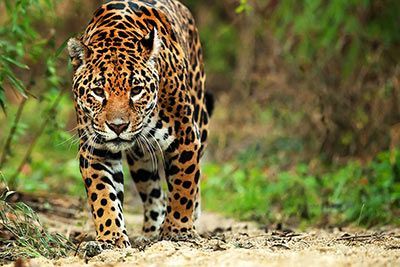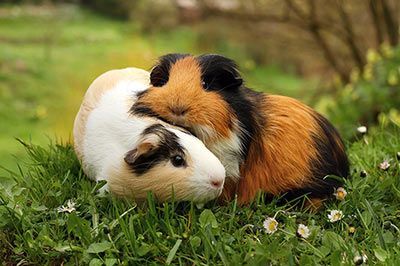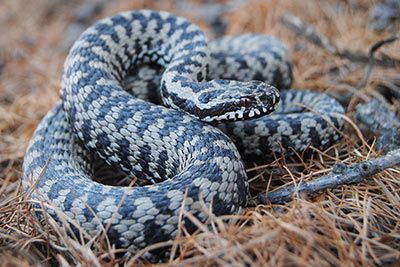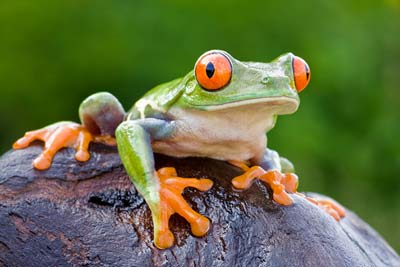Roe Deer
Roe Deer Facts
| Size | 24-26 inches (63-67 cm) (shoulder height) |
| Speed | 37 mph (60 km/h) |
| Weight | 22-77 pounds (10-35 kg) |
| Lifespan | 8-15 years |
| Food | Grass |
| Predators | Wolves, bears, lynxes, birds of prey |
| Habitat | Europe, Asia Minor |
| Order | Even-toed ungulates |
| Family | Cervidae |
| Scientific name | Capreolus capreolus |
| Characteristics | Small, slim deer; antlers only on bucks |
Main Characteristics
The roe deer is the most common and smallest species of deer in Europe. It is also called European roe. Its most striking features are the slim body, the black nose and the white fur on the rump. The male animals have short antlers on their heads.

Species
The roe deer belongs is closely related to the red deer, fallow deer, reindeer and moose.
Terms
What are the names of the male and female animals?
- Male deer (adult) = buck, roebuck
- Female deer (adult) = doe
- Young animal, baby = fawn, fawn
Distribution and Habitat
In Europe, roe deer are very common and widespread. They prefer forest clearings and forest edges. When there is danger, they can quickly get to safety in the forest. However, they avoid overly dense forests with lots of undergrowth. Nowadays, they can be observed more and more frequently in fields, which is due to the increase in agriculture.
Life Style
Roe deer are active during the day. Unfortunately, they're increasingly being disturbed, which results in them being active at night instead. In summer they tend to live alone or in small groups - for example the mother and its young. In winter, groups of up to 20 animals form.

Anatomy and Appearance
Body
Roe deer have a delicate body structure. They have slender legs, a slim body, small hooves and oval ears. The males are slightly larger and heavier, the females are smaller and lighter.
Size and Weight
Roe deer have a shoulder height of 24-26 inches (63-67 cm), a body length of 37-53 inches (95-135 cm) and a weight of 22-77 pounds (10-35 kg).
Fur
Roe deer have reddish-brown to brown fur in summer. In winter it turns gray-brown so that they are well camouflaged in the barren landscape. There is a white spot on the rump. Fawns have many small, white spots on their fur.

Antlers
Size and Appearance
Compared to other deer species, the antlers of roe deer are rather short. It only grows to about 6-8 inches (15-20 cm) long and weighs about 21 ounces (600 grams). It is made of bones.
Only Male Deer Own Antlers
Male and female deer are easy to tell apart: males have antlers, females don't.
Do They Need Their Antlers for Defense?
Deer don't need their antlers to defend themselves against predators - because then the females would have antlers too.
What Is the Purpose of Roe Deer Having Antlers?
Antlers in roe deer are used as a way to show strength and intimidate rival males in the breeding season. They run towards each other, lower their heads and thrust their antlers towards their rival. Luckily, it's not about seriously hurting him. The animals just want to find out who is stronger.
Why Do They Shed Their Antlers?
When roe deer fight with their fellow species, the antlers are often damaged. This is why they shed it once a year. It usually happens right after the mating season, when they don't need it anymore.
Will their Antlers Grow Back?
Yes, roe deer begin to regrow their antlers shortly after the mating season. At the beginning they're covered in layer of velvety, soft skin. It supplies the antlers with nutrients and accelerates growth. Before the mating season they rub their antlers on trees to get rid of the skin.

Roe Deer, Red Deer or Fallow Deer - What's the Difference?
How do you tell roe deer, red deer and fallow deer apart? They all have a similar appearance, leading to frequent confusion. Here are their main differences: Red deer and fallow deer are twice as big, twice as heavy and have at least twice as big antlers. In contrast to roe deer, they also have a visible tail. Fallow deer are particularly easy to recognize by their fur: they have small, white spots everywhere. In roe deer, only the fawns have such spots.

Diet
Roe deer are herbivores and belong to the ruminant family. This means that they bring the food up from the stomach again and chew it a second time before it is finally digested. They mainly eat grasses, buds, foliage shoots, herbs and ferns. In winter they also feed on blackberries.
Behavior
Communication
Do roe deer make sounds? It might seem strange, but they bark - like a dog! They bark when they feel threatened or want to let others know where they are. Rickets and fawns peep to keep in touch. The bucks whistle to win over a doe or to drive away bucks.
Senses and Abilities
Sense of Hearing
Roe deer have excellent hearing. They hear sounds twice as high as humans.
Sense of Sight
Roe deer don't have good vision. They are also red-green blind. However, at night they see better than we humans.
Sense of Smell
Roe deer have an excellent sense of smell. They easily detect predators 1,000-1,300 feet (300-400 meters) away - if the wind is right. They use their sense of smell primarily to communicate with each other. For example, when they sniff a fellow animal, they learn whether it is healthy or sick. Their smell comes from special scent glands. They're located on the forehead, on the abdomen. and on their hind legs.
Speed
Roe deer are known for their impressive speed when running. They reach speeds of up to 37 mph (60 km/h).

Life Expectancy
In the wild, roe deer live to be 8-15 years old.
Enemies and Threats
Natural Enemies
Their natural enemies are primarily wolves, bears, lynxes and birds of prey.
Cars
Humans also pose a major threat to the animals. When crossing roads, they are often hit by cars and fatally injured.
Combine Harvesters
Fawns do not flee, but lie quietly in the tall grass when threatened. That's why they often fall victim to combine harvesters.
Walkers
Roe deer flee as soon as they smell people and don't come back until the place seems safe again. This is a serious disruption for the animals, especially during the mating season.
Free-Roaming Dogs
Free-roaming dogs are another problem. They hunt roe deer and injure them seriously or even fatally. If the mother dies, so will its little fawns. Please always keep your dog on a leash in the forest and especially during breeding season.
How To Protect Roe Deers
Can I Touch a Deer?
What to do when you find a fawn? Don't touch it! While the idea of stroking the young animal may be tempting, the transfer of human scent through touch results in the mother rejecting it, ultimately leading to the fawn's unfortunate death.
What Should I Do If I Find a Fawn?
The mother usually appears after a short time. If the fawn is alone for an extended period and cries out in distress, it is advisable to contact the forest ranger for assistance.

Reproduction
Mating Season
The mating season usually takes place in July and August. This is very early for a deer species and would result in the young being born in winter. However, in winter the food supply is very scarce and the young couldn't survive. Here is the trick:
Deer “Postpone” the Gestation Period
Deer are the only ungulates which can delay their gestation period. It begins in December and lasts until around May or June. Usually two to three fawns are born.
Fawns Are Well Camouflaged
The babies have white spots on their fur for camouflage. When their mother isn't around, they lie quietly on the grass to avoid being discovered. At two years old they are adults.
Fun Facts
Hunter Language
In Germany, hunters use their own terms to name parts of the roe deer. Here are some examples. The fur is called a “blanket,” the eyes are called “lights,” and the ears are the “eavesdroppers.” The white fur on their backside is called “mirror”.
The Roe Deer Related To:
Animals in the Same Biome:
- Beaver
- Brown Bear
- European Peacock
- Golden Eagle
- Lynx
- Red Deer
- Wolf




















